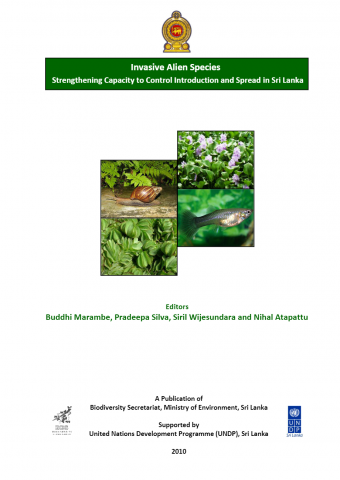
Invasive alien species (IAS) are considered to be a main and a direct driver of biodiversity loss across the globe, and Sri Lanka is not an exception. These IAS have been estimated to cost our economies enormously every year and is a major threat to sustainable development. All alien species will not become invasive or threaten the environment, however, alien always will have the nag with their potential to become invasive once escaped from human management. A clear policy approach is hence required for a country in order to effectively deal with the wide-ranging negative impacts of IAS, including the financial costs and irreversible effects on the environment. Sri Lanka is a signatory to the Convention on Biological Diversity (CBD), which clearly articulates the role-play of the countries (article 8(h), to overcome the threats of IAS to the biodiversity. IAS are a problem in the diverse ecosystems of Sri Lanka. The Biodiversity Secretariat of the Ministry of Environment of Sri Lanka, being the focal point for implementing the CBD in the country, has taken keen interest activities focusing on IAS control at various levels in the society. The national action plan for the Haritha Lanka programme published by the National Council for Sustainable Development (NCSD) of the Presidential Secretariat of Sri Lanka has identified management and control IAS as a necessity under its activity 8.2, while the Cabinet of Ministers of the country has approved (on 15th January 2009) the formulation of a Invasive Species Control act, thus indicating the high priority given by the country in this subject. However, still, it is evident that a proper coordinating mechanism with authority, responsibility and accountability, together with capacity building of stakeholders across all sectors, is a must for achieving the country’s long term goals in overcoming the impacts of IAS. This publication is aimed at providing necessary information to the scientists, academic, policy makers and other interested parties in understanding various aspects of IAS in Sri Lanka. This book comprises of 20 chapters out of which 13 chapters are devoted to assessing the present status in terms of definitions, national lists, risk assessment protocols, institutional arrangements, legal and policy frameworks, education and awareness strategies, IAS control efforts, etc., while the remaining 7 chapters deal with recent research activities on IAS. The information included in this book is up-to-date and it is our fervent hope that this publication will provide information to all those who are proactively taking part in the country’s efforts to free the ecosystems from the menace of IAS.
